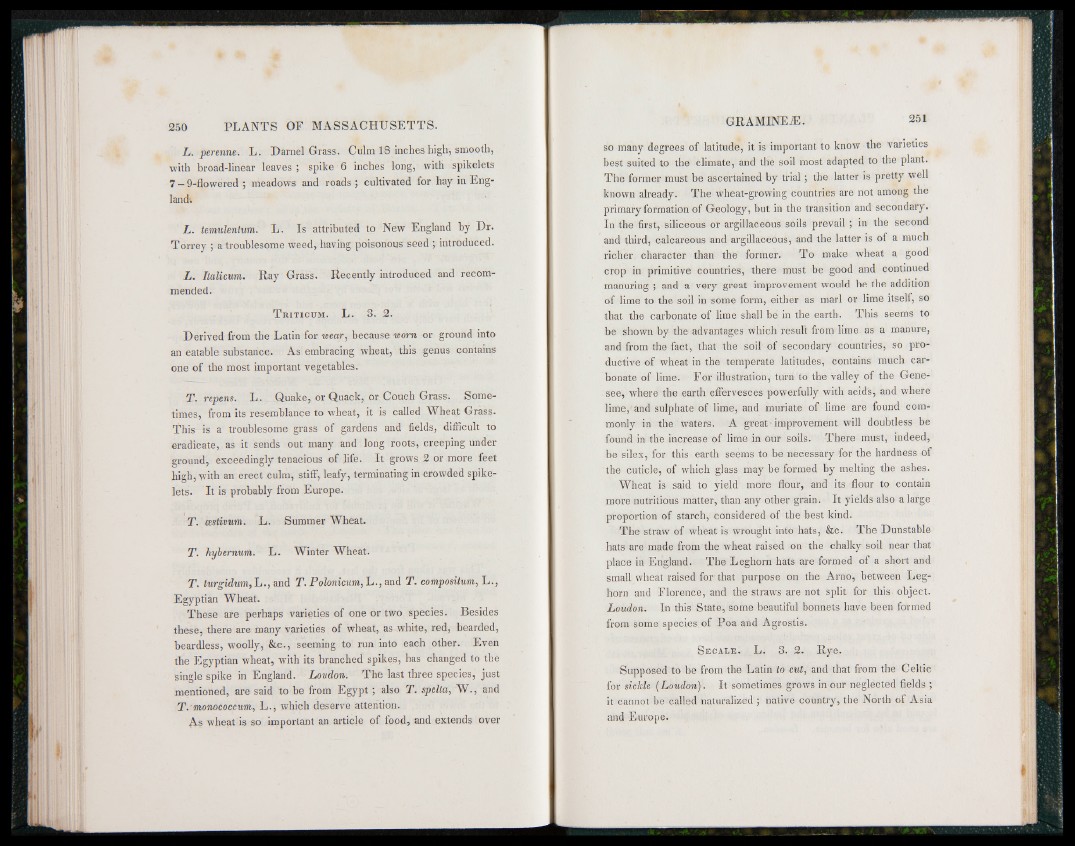
L. perenne. L. Darnel Grass. Culm 18 inches high, smooth,
with broad-linear leaves ; spike 6 inches long, with spikelets
7-9-flowered ; meadows and roads; cultivated for hay in England.
L. temulentum. L. Is attributed to New England by Dr.
Torrey ; a troublesome weed, having poisonous seed ; introduced.
L . Italicum. Ray Grass. Recently introduced and recommended.
T riticum. L. 3. 2.
Derived from the Latin for wear, because worn or ground into
an eatable substance. As embracing wheat, this genus contains
one of the most important vegetables.
T. repens. L. Quake, or Quack, or Couch Grass. Sometimes,
from its resemblance to wheat, it is called Wheat Grass.
This is a troublesome grass of gardens and fields, difficult to
eradicate, as it sends out many and long roots, creeping under
ground, exceedingly tenacious of life. It grows 2 or more feet
high, with an erect culm, stiff, leafy, terminating in crowded spike-
lets. It is probably from Europe.
T. CBstivum. L. Summer Wheat.
T. hybernum. L. Winter Wheat.
T. turgidum, L ., and T. Polonicum, L ., and T. compositum, L .,
Egyptian Wheat.
These are perhaps varieties of one or two species. Besides
these, there are many varieties of wheat, as white, red, bearded,
beardless, woolly, &c., seeming to run into each other. Even
the Egyptian wheat, with its branched spikes, has changed to the
single spike in England. Loudon. The last three species, just
mentioned, are said to be from E g y p t; also T. spelta, W., and
T.'monococcum, L ., which deserve attention.
.As wheat is so important an article of food, and extends over
so many degrees of latitude, it is important to know the varieties
best suited to the climate, and the soil most adapted to the plant.
The former must be ascertained by trial; the latter is pretty well
known already. The wheat-growing countries are not among the
primary formation of Geology, but in the transition and secondary.
In the first, siliceous or argillaceous soils prevail ; in the second
and third, calcareous and argillaceous, and the latter is of a much
richer character than the former. To make wheat a good
crop in primitive countries, there must be good and continued
manuring ; and a very great improvement would be the addition
of lime to the soil in some form, either as marl or lime itself, so
that the carbonate of lime shall be in the earth. This seems to
be shown by the advantages which result from lime as a manure,
and from the fact, that the soil of secondary countries, so productive
of wheat in the temperate latitudes, contains much carbonate
of lime. For illustration, turn to the valley of the Genesee,
where the earth effervesces powerfully with acids, and where
lime,'and sulphate of lime, and muriate of lime are found commonly
in the waters. A great improvement will doubtless be
found in the increase of lime in our soils. There must, indeed,
be silex, for this earth seems to be necessary for the hardness of
the cuticle, of which glass may be formed by melting the ashes.
Wheat is said to yield more flour, and its flour to contain
more nutritious matter, than any other grain. It yields also a large
proportion of starch, considered of the best kind.
The straw of wheat is wrought into hats, &c. The Dunstable
hats are made from the wheat raised on the chalky soil near that
place in England. The Leghorn hats are formed of a short and
small wheat raised for that purpose on the Arno, between Leghorn
and Florence, and the straws are not split for this object.
Loudon. In this State, some beautiful bonnets have been formed
from some species of Poa and Agrostis.
S ecale. L. 3. 2. Rye.
Supposed to be from the Latin to cut, and that from the Celtic
for sickle (Loudon). It sometimes grows in our neglected fields ;
it cannot be called naturalized ; native country, the North of Asia
and Europe.